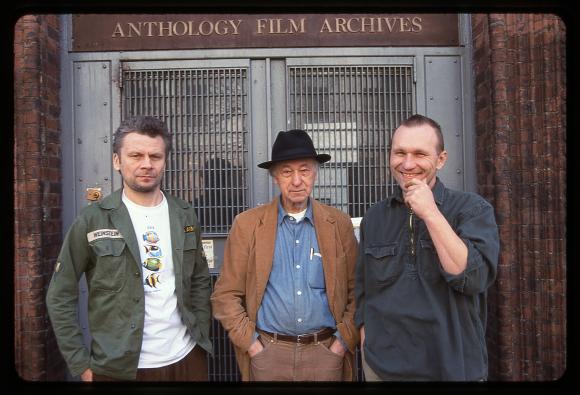Scanorama premiere. Teacher of Freedom

It is hardly fair to second the film's trailer, which claims that the new documentary "Back from New York" is the story of "two unique and acclaimed artists". Rather, it is a reverence for the teacher Jonas Mekas. Perhaps it is also a biography, but not of two people, but of a whole generation of Lithuanian creators who, after the fall of the Soviet Union, had the opportunity to visit the Anthology Film Archive in New York, founded by Mekas, and to breath in the freedom of life (cultural and otherwise) that was so lacking for young people at that time. It’s no surprise that the premiere of the film at the European Film Forum Scanorama was attended by a number of Mekas' students, including the director of "Back from New York", Ramunė Rakauskaitė, and the film's producer, filmmaker Arūnas Matelis. It seems that for some, the film has become a nostalgic journey through their own experiences, for others – a chance to see behind the scenes of the legend (I mean not only Jonas Mekas, but also the visits to him by the young artists of that time).
The film starts with archival footage from the 1990’s: New York, Mekas, parties, countless faces, colours and noise. Art everywhere, wherever you want it and whatever you want it. And all captured with an amateur camera on videotape - in nostalgic format that is inseparable from capturing the everyday life of those times. Soon this chaos of sensations is interrupted, a still picture appears and the viewers find themselves in the complete antipode of the life they had seen before – a green Lithuanian farmhouse. The busy, never-sleeping streets of New York are replaced by the endless fields of Ukmergė district, the silence is disturbed only by a herd of bleating sheep, and time seems to pass twice slower than in the city of Mekas. Here we meet the first protagonist of the film, photographer Arūnas Kulikauskas. After two decades in the USA, he has now settled with his family in the Lithuanian countryside. "You still take photographs?” – a neighbour who came by to help slaughter a sheep is surprised. Here's another contrast to the new life. We meet the second protagonist of the film, the painter Eugenijus Varkulevičius-Varkalis, in his studio in Kaunas. Same as Kulikauskas, after spending a decade with Mekas, he has returned home to continue his work.
The director's attempt to make "Back from New York" a personal story of these two artists is perhaps the part of the film that raises most questions. The desire to show their experiences through an individual lens – what their life was like and what is it now, how it was affected by Mekas – is understandable, but the film's observation of the biographical nature of the specific individuals is too vague. It can be called universally intimate (a whole generation of artists who had visited Mekas share similar experiences), but not individual. Therefore, the inserts that appear about the personal reasons for the return of the film's protagonists, the stories about the wife or the domestic scenes with the children are present in the film with the rights of a foreign body – they are too few to create an individualised portrait, and too many to not stand out from the context.
More important is the footage captured by Kulikauskas and Varkulevičius during their years in the USA. It is experiential, as if you were observing everything from behind the shoulders of those who participated. It is not clear if it objectively conveys the entire everyday life of the film's protagonists, but it certainly allows you to experience the authentic atmosphere that existed behind the doors of the Anthology Film Archive. Endless events, conversations over wine, music and cinema – all of life is inseparable from art and creativity. And, of course, Jonas Mekas himself. Reading his poetry, open to the world, communicating directly and willing to share what he has with others. Apparently, this was the greatest asset for those who visited him – the community created by Mekas, community that liberates rather than judges or condemns.
Although this episode of life comes to an end, we continue to see the traces left by Mekas in the life of the creators in Lithuania. In the film, we can observe an exhibition organised by Kulikauskas, which also captures the motifs of Mekas and life in the USA. However, the most important are probably not the physical signs, but the perceived creative freedom that bursts out of the film's protagonists – in one scene, the film's protagonists are not even deterred by the fact that a friend invited to the musical dialogue is not in the same room, but on the other side of the Atlantic.
The film ends with a concert scene – Dalius Naujokaitis, a friend of Kulikauskas and Varkulevičius, who came from the USA, beats the drums. Varkulevičius picks up the saxophone, just like in the old days, and a group of girls sing the lines of Jonas Mekas. Music and freedom unite different generations – in a small, crowded space, everyone moves to the same rhythm, and the spirit of Mekas is alive here again.